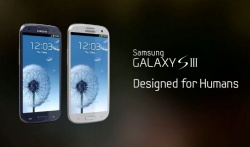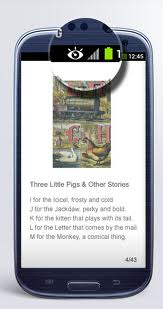Difference between revisions of "Galaxy S3"
| Line 1: | Line 1: | ||
| − | [[File:gs3.jpg|200px|thumb|right|Phone logo]] | + | [[File:gs3.jpg|200px|thumb|250 px|right|Phone logo]] |
The '''Samsung Galaxy S III''' is a flagship mobile phone designed by Samsung Electronics. The Galaxy S III is powered by an Android 4.0.4 "Ice Cream Sandwich"<ref> Samsung Galaxy S III Official Specifications [http://www.samsung.com/global/galaxys3/specifications.html] </ref> operating system and uses a quad-core processor. The Galaxy features eye-tracking ability, increased storage, and wireless charging options. The device comes with a 4.8 inch screen and it supports 4G network and LTE. | The '''Samsung Galaxy S III''' is a flagship mobile phone designed by Samsung Electronics. The Galaxy S III is powered by an Android 4.0.4 "Ice Cream Sandwich"<ref> Samsung Galaxy S III Official Specifications [http://www.samsung.com/global/galaxys3/specifications.html] </ref> operating system and uses a quad-core processor. The Galaxy features eye-tracking ability, increased storage, and wireless charging options. The device comes with a 4.8 inch screen and it supports 4G network and LTE. | ||
The device was released on 3 May 2012 in London, and was anticipated to be the greatest competitor to Apple's iPhone 4S. | The device was released on 3 May 2012 in London, and was anticipated to be the greatest competitor to Apple's iPhone 4S. | ||
Revision as of 22:56, 29 November 2012
The Samsung Galaxy S III is a flagship mobile phone designed by Samsung Electronics. The Galaxy S III is powered by an Android 4.0.4 "Ice Cream Sandwich"[1] operating system and uses a quad-core processor. The Galaxy features eye-tracking ability, increased storage, and wireless charging options. The device comes with a 4.8 inch screen and it supports 4G network and LTE. The device was released on 3 May 2012 in London, and was anticipated to be the greatest competitor to Apple's iPhone 4S.
Contents
About Company
In 1939, Lee Byung Chul, the founder of Samsung started with a small trade company that consists of just 40 employees selling groceries and homemade noodles. After war broke out in 1950, Lee started Wooden Mill factory, which became a huge success. Following the success of wooden mill, Lee expanded his business to different areas such as insurance, security, and retail. Now, Samsung has become a multinational conglomerate company in South Korea, employing over 42,000 people. Samsung's main headquarters are located in Seoul, Korea's largest and most technologically advanced city. The company comprises numerous subsidiaries and affiliated businesses, most of which are united under the Samsung brand.
Features
Operating System
Originally released with a Android 4.0.4 (Ice Cream Sandwich). Samsung will update US Galaxy S III to the Android 4.1 "Jelly Bean", the latest version of the Android platform, "in the coming months". [2]
Design
The Samsung Galaxy S3 is inspired by nature: the body has smooth and gentle curves, the material is made of brushed polycarbonate – a choice of 'Marble White' and 'Pebble Blue' with dimensions of 136.6 x 70.6 x 8.6mm, 4.8-inch Super AMOLED HD screen. The screen is made out of Gorilla Glass 2 front, a well-packaged interior, and a more robust battery cover.
Specification
Dimension: 136.6 x 70.6 x 8.6 mm Memory: 16/32 User memory (65GB available) Colour: Pebble Blue, Marble White, Saphire Black, Ruby Red. Battery: 2,100 mAh Connectivity: WiFi a/b/g/n, WiFi HT40 Audio Codec: MP3, AMR-NB/WB, AAC/AAC+ /eAAC +, WMA, OGG, FLAC, AC-3, apt-X Video Codec: MPEG4, H.264, H263, DivX, DivX3.11 Playback: Full HD(1080p) Camera: 8 Mega Pixel(back) 1.9 Mega pixel(front), HD recording@30 fps with Zero Shutter Lag
Sharing
S beam - share pictures, music, and video by placing 2 Galaxy phones back-to-back. AllShare Cast - Use as s controller for other Samsung electronics. AllShare Play - Share your files with others without being next to the computer. Buddy Photo Share - Share your photos with your buddies instantly.
Enhancement
Enterprise Mobility Features, Smart Keyboard, Accessories
Competitors
Some of the major competitors are: Apple iPhone 5, Sony Xperia Ray, Nokia Lumia 800, and LG Optimus
Predecessors
Galaxy S
The Galaxy S is the first predecessor of the Galaxy S III. It was first launched in South Korea in June, 2010, followed by 100 countries on 110 carriers. It was received very well globally and was named number 2 in Time’s Top Ten Gadgets of the Year list in 2010. The Galaxy S received praise for its Super AMOLED display, boasting a 20% brighter display, its speed at the time, its memory capacity, its extended battery life, and its size. The Galaxy S uses the “Hummingbird” Processor, making it the fastest Android at the time. Samsung also claimed it was the thinnest touchscreen phone, measuring at 9.9mm deep. Criticism for the Galaxy S was based on its lack of 4G Network availability and its 5mp camera, while competitors such as the Sprint EVO 4G supported 4G data and had an 8mp camera.
Galaxy S II
The Galaxy S II is the most recent predecessor of the Galaxy S III. It was first launched in May of 2011 by Samsung, and is now sold in over 140 countries on 120 carriers. It received high ratings globally and was named the “The Smartphone of the Year 2012” in the Global Mobile Awards. It was praised for its bright screen with the Super AMOLED display, its fast processor, and for being one of the slimmest smartphones, measuring in at only 8.49mm deep. Criticisms of the phone include the location of the speaker, the very large screen (4.3 in), and the moderate battery life.
Litigation
Apple Inc. filed initial lawsuits against Samsung Electronics in patent infringement suits. Apple claimed Samsung infringed intellectual property by improper use of trademark, Samsung's patents, user interface, and style. Samsung then counter-sued Apple by claiming that Apple copied Samsung mobile-communications technology. Litigations between Samsung and Apple were 19 cases in 9 countries. Recently, Apple won the battle in the US: the verdict was Samsung did infringe Apple's patents.
Patent Violations
Apple accused Samsung on 7 patents and Samsung was found guilty on 6 out of 7 accusations.
For the functionality of phone: Pinch and Zoom, Bounce-back effect, Drag documents, and Scroll using one finger.
For the Design: Rectangular with round edges and icons on the screen.
What does this litigation verdict mean?
The main idea of this litigation is to protect against copying Intellectual Property and the rights of innovators.
For Apple: No effect in their business practice. Apple collects royalties from those who are willing to use Apple patents.
For Samsung: Stop selling phones that are infringed by this litigation. Samsung should spend more money on research and development.
For Innovator: Have more time to focus on their innovation rather than worrying about protecting their ideas.
For Everyone else: Higher cost for a mobile phone because consumer will have a limited options.

